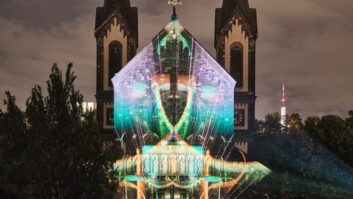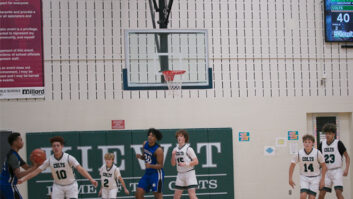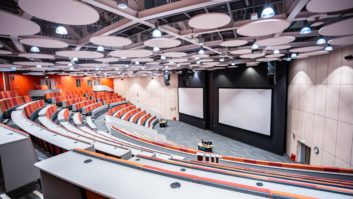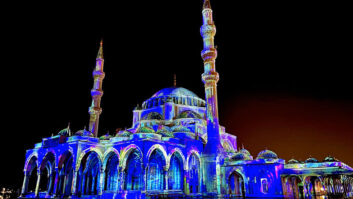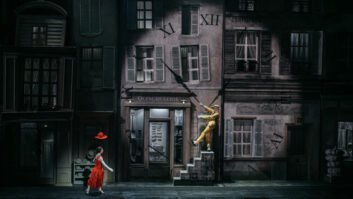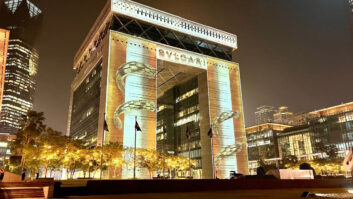The new £42m Southampton head office of Great Britain’s national mapping agency Ordnance Survey boasts a state-of-the-art audiovisual installation courtesy of Racetech and Christie. When Ordnance Survey, Great Britain’s national mapping agency, purchased the 16 acres of land at Adanac Park for its new state-of-the-art Southampton head office, the organisation was determined that the £42m project would be environmentally sympathetic. The three-storey building, known as Explorer House, benefits from a number of natural resources and renewable energy sources at the heart of a sustainable development. This provides a modern and efficient workspace suited to an information business for a workforce of 1100 staff, including surveyors and cartographers. The audio visual infrastructure needed to emulate that concept. The giant atrium at the centre of the building forms the social hub of the head office, employing both customer and staff-facing technologies, and linking the offices with the business centre. Today’s Ordnance Survey is a far cry from the origins of the 220-year old business, originally set up to map the south coast of England for fear of invasion by Napoleon. Today it is a £130 million-a-year public sector organisation collecting, maintaining and distributing geographic data that helps underpin everything from rubbish collection to planning flood defences.@page_break@
Central in planning the phased relocation from the nearby premises they had occupied for 40 years, and contracting for the specialist services was Ordnance Survey’s building and property services manager Greg Tumilty. Reviewing the requirement, Greg Tumilty says: “As a leading mapping organisation, with a role to play across the world, we wanted to make sure budgets were spent carefully and that the facilities would meet our requirements in the long term.” Over 100 companies responded to the tender for the building’s audio visual systems from which RaceTech — who themselves have a history dating back 65 years, with a background in broadcast, satellite and racing technology — were successful. A wide range of Christie projectors were chosen exclusively to meet the requirements laid down in the original core specification document, but the requirement developed organically once the staff moved in and the organisation understood how the building could be used most effectively. Mark Jennings, head of RaceTech Audio Visual Commercial & Strategic Partners, based the decision to select Christie on the company’s broad product portfolio, performance and proximity to site, which he knew would guarantee any necessary support. “We wanted a strong brand, a single vendor with an end-to-end range of high-end business and high definition projectors, and the benefit of local support. “We also recognised the low total cost of ownership of the Christie projectors and the fact that they generated low noise. There are many options in that class of projector but the Christie products seem slightly brighter than most and run slightly quieter — plus they provide an appropriate lens option.” With the business move scheduled for October 2010, as a precursor to being fully operational by February 2011, the developing relationship between Tumilty and Jennings was vital, as the concept evolved considerably during the second phase fit-out.@page_break@
“One of the key reasons RaceTech won the tender was because we were confident of forming a long-term, sustainable relationship, and the fact they had a real feel for the dynamic of the building,” says Tumilty. “We had a fairly basic boardroom and lecture theatre in our old building, but this new building had to represent a 21st century business and with that was a greater need for cutting-edge technology. What we were looking for was ease of use, no visible wires and quality of experience, with detail of projected mapping one of the key criteria.” This co-operation was no more evident than in the 180-seat Solent lecture theatre, where the original Christie HD10K-M, designated as the mapping projector in 1920 x 1080 high definition, was later complemented by a second 1-chip HD projector (Christie DHD800), mounted on a scissor lift and facing in the opposite direction. This now projects onto an electric drop-down Da-Lite screen over a removable stage as required, complete with double drapes and LED colour-changers; this enables a wide range of different events (with breathtaking reveals) to be staged. Elsewhere, of the available rooms around the building, ten are Christie-equipped. Selected were seven LW555 3LCD 5500 lumen WXGA projectors for widescreen resolution in the various training, meeting rooms and boardroom and an LX1000 3LCD XGA projector, using all of its 10,000 ANSI lumens output to throw branding and core messages through the natural brightness generated at the atrium’s heavily-glazed front of house. At the same time the displays around the café and mezzanine areas can also receive signage streams for both visitors and staff. The AV environment operates under Crestron touch screen control and with the many differently-configured meeting spaces in high demand, their Room View booking solution is integrated on the Ordnance Survey centralised Exchange Server and Calendaring system; this allows for easy booking of rooms via touch screen panels or across the HQ’s IT infrastructure — and as with the localised LED and fluorescent lighting the content source selection is controllable via touch panel controllers. The fact that Greg Tumilty’s front-of-house team has already quadrupled the number of people visiting the site speaks for itself. “Internally everyone loves the new media systems; the Christie/Crestron solution meets the expectations and in many cases exceeds it. We haven’t explored all the possibilities yet — who knows what we can achieve over the next few years.”
www.christiedigital.eu
